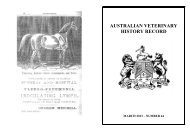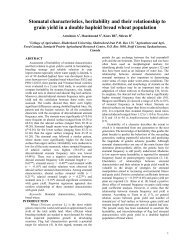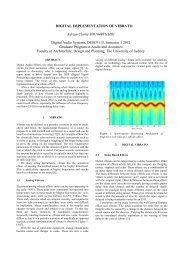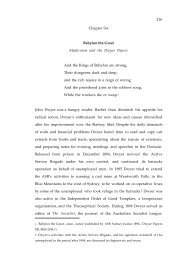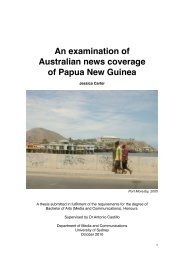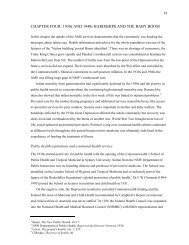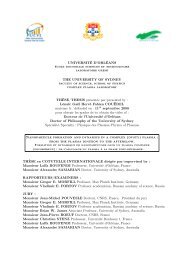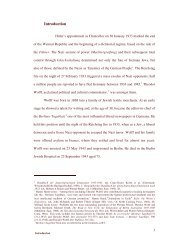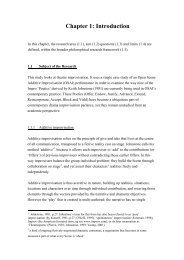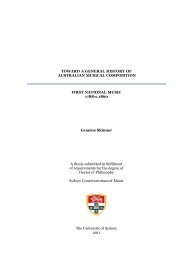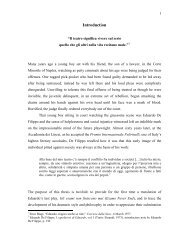journal of digital research & publishing - The Sydney eScholarship ...
journal of digital research & publishing - The Sydney eScholarship ...
journal of digital research & publishing - The Sydney eScholarship ...
Create successful ePaper yourself
Turn your PDF publications into a flip-book with our unique Google optimized e-Paper software.
1 P M J O U R N A L O F D I G I T A L R ESEARCH & P UBLISHING<br />
Unlike print, the magazine website is a culmination <strong>of</strong> technological and visual formats<br />
that create cultural practices, such as the formation <strong>of</strong> an online chat forum, like the<br />
‘Cosmolicious’ message board where members can talk about a variety <strong>of</strong> issues from men<br />
to fashion in Cosmopolitan. Although the magazine website has many advantages over the<br />
print version such as immediacy <strong>of</strong> content, and the fact that they are updated sometimes<br />
numerous times a day, they:<br />
…Provide news, exclusive features, longer versions <strong>of</strong> articles which have appeared in the<br />
printed magazine, a picture gallery, searchable diary dates, reader contribution options,<br />
a member’s portfolio facility and online shopping featuring exclusive online <strong>of</strong>fers…<br />
(Ingham & Weedon 2008, p.209)<br />
It must be noted that the magazine website has not had to ‘work’ as hard as the print<br />
version in getting reader’s attention as the print magazine has already done that for them.<br />
`",+3"& T& i%%87"& .V;;W1S& 3D4>0& 6+36& 6+%& 03,3K$"%& G%)*$6%& X+3*& "76& +38& 67& $"I%*6& $"&<br />
advertising to secure readers, although it has been the subject <strong>of</strong> crosspromotion within<br />
the printed magazine’ (p.209). In essence, the magazine website could be described as ‘a<br />
natural extension <strong>of</strong> the magazine’ (Taylor 2007, p.26) and with their extreme interactive<br />
natures, ‘a great editorial and marketing tool’ (Taylor 2007, p.26) that promotes the brand.<br />
Hence it is no surprise that ‘<strong>publishing</strong> as a whole has embraced the online magazine<br />
format with considerable success.’ (Inghan & Weedon 2008, p.206) As magazine<br />
publishers approach the web content as it’s own entity and rather than competitive to print,<br />
570'#%0%"63>9S&6+(*&3&X*90)$76$5&>%#36$7"*+$'&+3*&)%%"&5>%36%8&3"8&$6L*&67&6+%&)%"%46&7D&<br />
all – reader, publisher and advertiser.’ (Taylor 2007, p.24) It must be noted that both print<br />
and online versions <strong>of</strong> the magazine have different objectives. <strong>The</strong> print magazine’s goal<br />
is to create something permanent and beautiful for the reader, that they can hold, collect<br />
and rip out pages if need be. Evidence <strong>of</strong> this can be seen through NME’s poster section<br />
in the print magazine where beautiful highquality photographs <strong>of</strong> musicians are placed<br />
throughout the magazine. <strong>The</strong> magazine website however, is updated constantly, a source<br />
for extra information, interactivity and a place where readers can come together and form<br />
a community based around the magazine. Furthermore this growth away from the print<br />
version is functional in design as opposed to stylistic, although <strong>publishing</strong> houses are still<br />
intent on representing the brand whilst acknowledging, ‘the different objectives <strong>of</strong> the two<br />
different products – print and screen’ (Taylor 2007, p.27).<br />
Cosmopolitan’s website is highly visual and targets the young women demographic<br />
49



